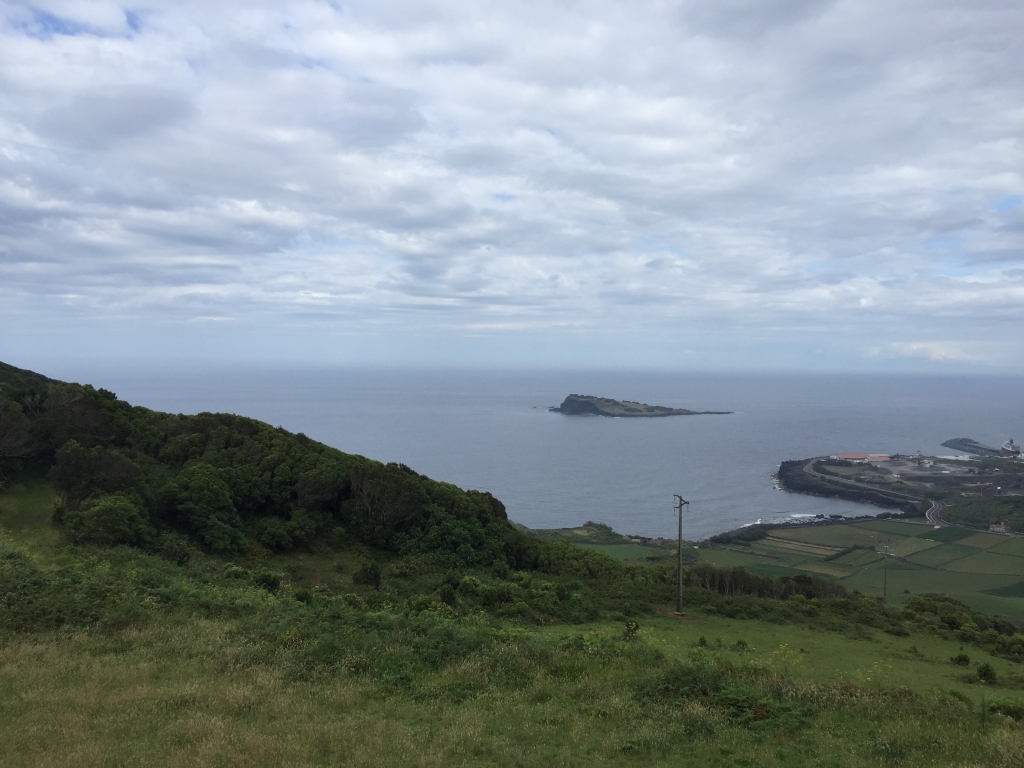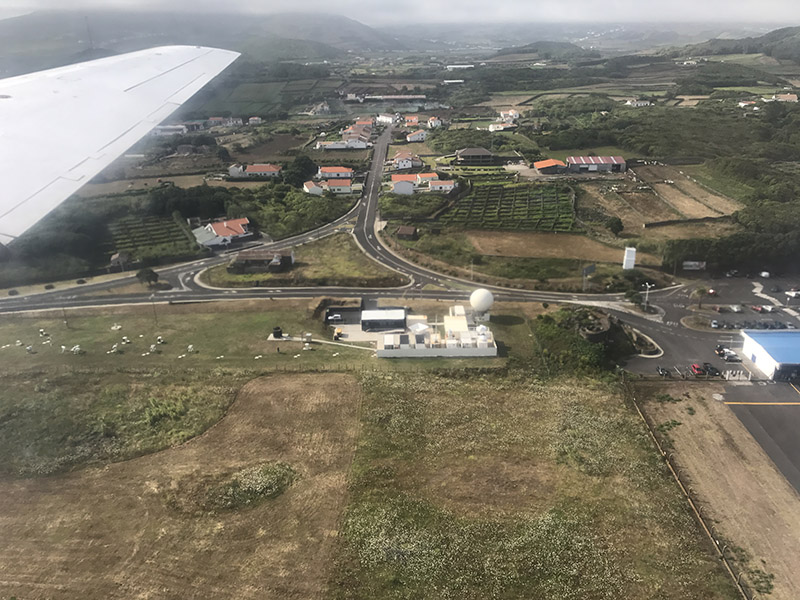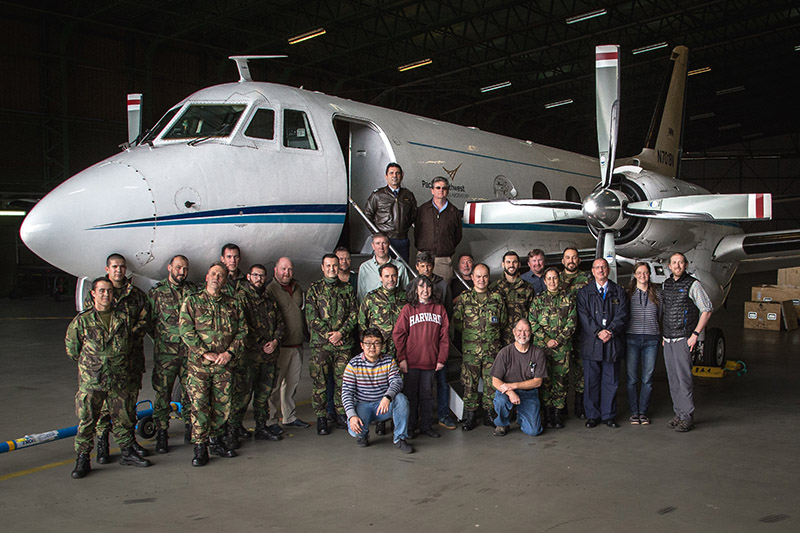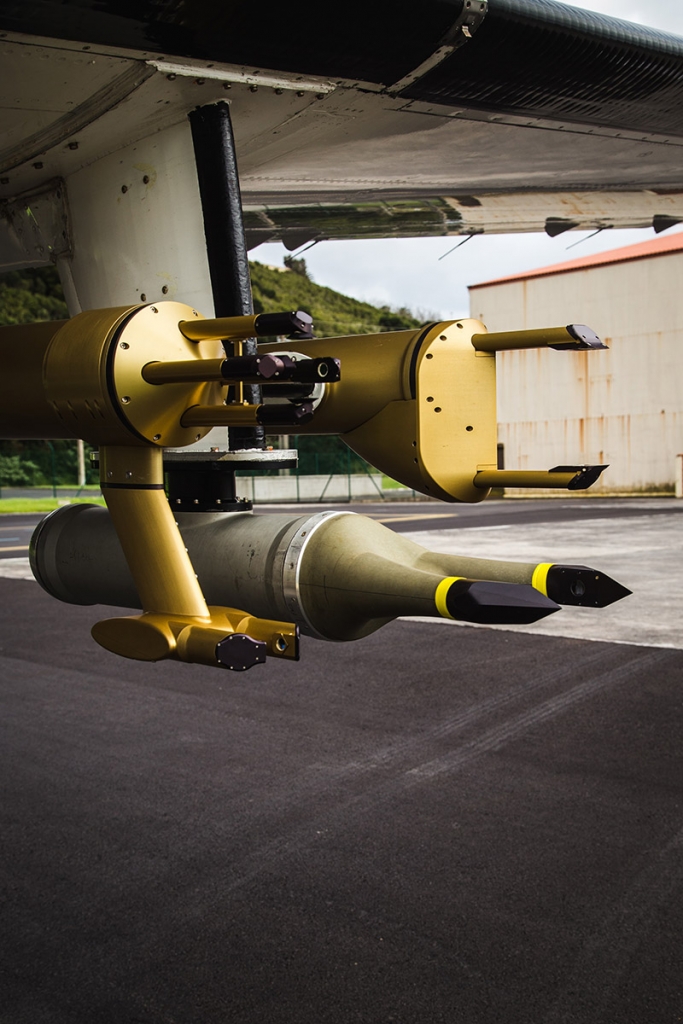Field Campaign Confirms Seasonal Variations in Properties of Low Marine Clouds and Aerosols
Published: 19 June 2018
More findings are expected from Aerosol and Cloud Experiments in the Eastern North Atlantic

A combined ground and aerial campaign recently wrapped up in the Azores that could help improve the representation of aerosols (tiny particles in the air) and low clouds in earth system model simulations.
The Aerosol and Cloud Experiments in the Eastern North Atlantic (ACE-ENA) field campaign, which focused on the study of aerosols and low clouds in a remote marine setting, took place during two intensive operational periods (IOPs): summer 2017 (June and July) and winter 2018 (January and February).
ACE-ENA required ground-based measurements from the Atmospheric Radiation Measurement (ARM) user facility’s Eastern North Atlantic atmospheric observatory on Graciosa Island, in addition to airborne data acquired aboard ARM’s Gulfstream-159 (G-1) research aircraft. The aircraft was stationed at Lajes Field, a military base run by the Portuguese air force, on Terceira Island.
While early data analysis continues for ACE-ENA, researchers have confirmed several key seasonal variations in aerosol and cloud properties. They saw higher aerosol concentrations during the summer, while winter observations showed layers with very low aerosol concentrations. The boundary layer was deeper and remained more well mixed in the winter. More warm rain and thicker clouds were observed during the winter, with increased precipitation contributing to lower aerosol concentrations.
ACE-ENA team members will gather for a two-day workshop in January 2019 at Brookhaven National Laboratory in New York to discuss their findings and plan future collaborations and papers.
“I would say there is a lot of interest from the scientific community for this field campaign,” says ACE-ENA principal investigator Jian Wang, an atmospheric scientist at Brookhaven National Laboratory. “I hope that it will lead to major discoveries in cloud and aerosol research.”
Rising Above the Obstacles

ACE-ENA is an important campaign because of the combination of ground- and air-based measurements in the marine environment. Ground-based cloud radars deliver information on the coverage and structure of cloud and drizzle fields, while airborne instruments glean data on what occurs within the clouds, such as the number and size of cloud droplets and drizzle drops.
The ACE-ENA team aimed to develop the best scanning strategy for the cloud radars to supply mesoscale and cloud life cycle context of in-cloud measurements from the G-1, which in turn provide microphysical details for validating the radar retrievals.
Initially, getting the desired conditions to sample proved difficult. During the first half of the summer campaign, there weren’t as many clouds as the team wanted. This led to a recurring theme for the G-1 flights.
“When the airplane arrived at the sampling station, which was closer to the ground site, most of the clouds had dissipated substantially,” says Wang.
Thankfully, the weather livened up and more drizzling clouds were seen toward the second half of the summer. Low clouds over the ENA drizzle 80 percent of the time, according to Wang. Drizzle is not well understood, but it can have a large effect on cloud and earth system properties.
“We actually had better sampling conditions at the beginning of the second IOP,” says Wang. “Later we had a few more days when it was more convective and it was kind of hard for the airplane to sample, but everybody was a little more relaxed because we knew we already got good data and were not as worried.”
When the G-1—built in 1961—began to show its age during the winter portion of ACE-ENA, the ARM Aerial Facility (AAF) crew worked diligently to get the aircraft back into full operational order. This included installing a part hand-delivered by a Brookhaven colleague who brought it from the United States.
“The AAF folks did a great job given the age of the aircraft,” says Wang. “Inevitably when you are dealing with such an old airplane, there could be a problem, but I think they did the best job to essentially minimize the downtime.”
The G-1 completed 19 flights in the winter versus 20 in the summer.
“After the plane was fixed again, we pushed hard,” says AAF Manager Beat Schmid from Pacific Northwest National Laboratory. “We had one week where we flew six times out of six.”
An International Partnership

The groundwork for ACE-ENA started about a decade ago, when ARM worked with the Portuguese government to set up a mobile facility and later the fixed ENA observatory in the Azores.
That long-standing relationship proved to be essential when ARM needed to bring in the G-1 for ACE-ENA.
“It was because of our existing ENA facility on Graciosa Island and because we already had existing diplomatic ties with most of the stakeholders that we were able to operate the aircraft without any major hurdles,” says Kim Nitschke, ENA facility manager from Los Alamos National Laboratory.
ACE-ENA co-investigator Eduardo B. Azevedo, a professor of applied climatology at the University of the Azores and an in-country ENA liaison, helped ARM secure use of the Portuguese air force hangar on Terceira Island. Successful negotiations and operations required support from the Portuguese ministers of science and defense, and from Col. Cesar Rodrigues, commander of the Portuguese air force base, and his staff.
“The whole process benefited from the fairness and persuasiveness of the team involved in the negotiations, in particular from Kim Nitschke’s ability to understand other countries’ sovereignty and assess local sensitivities,” says Azevedo.
Wang praised the Los Alamos and AAF teams for sorting out the G-1 logistics so the science team could work on designing the flight plans to obtain the best data.
“Without their hard work and expertise, we would not have a successful campaign,” says Wang. “I consider myself lucky to work with such a wonderful team from ARM that we were able to focus on the science and planning the flights.”
The Portuguese Meteorological Institute provided forecasting capabilities that helped inform the flight plans. Meanwhile, Nitschke’s office worked closely with the Regional Government of the Azores on export coordination and moving equipment in and out of Portugal.
“We can’t just set up in a foreign country and do what we want,” says Nitschke. “We work collaboratively with the country’s regulatory authorities to enable this to happen.”
Teamwork Equals Success

Coordinating the ground and air efforts of ACE-ENA required a lot of people to make it all work.
In addition to the crew at the ARM ENA observatory and AAF staff, the field campaign drew instrument mentors, data analysts, and weather forecasters from laboratories, universities, and other organizations around the world. Their shifts often started well before sunrise and ended many hours after the airplane completed its data-gathering flights.
Some key personnel weren’t even in the Azores. Working in the wee hours from their homes in New Mexico, ARM radar team members Peter Argay of Los Alamos National Laboratory and Todd Houchens of Sandia National Laboratories adjusted the ENA radars in accordance with the G-1’s daily flight plan.
ACE-ENA coordinated with nearby field studies such as the North Atlantic Aerosols and Marine Ecosystems Study (NAAMES), a NASA Earth Venture Suborbital mission taking place from 2015 to 2019, and measurements being collected at the Pico Mountain Observatory on Pico Island in the Azores.
Also, aerosol samples have been brought back to two DOE Office of Science national scientific user facilities—the Environmental Molecular Sciences Laboratory (EMSL) at Pacific Northwest National Laboratory and the Advanced Light Source at Lawrence Berkeley National Laboratory—for subsequent laboratory analyses.
The ACE-ENA team shared—and achieved—a goal to get the most out of the campaign, largely through collaboration and creativity in overcoming challenges that cropped up.
“We got a lot of data for the type of clouds and conditions we wanted, and most of the instruments worked quite well,” says Wang. “From a deployment point of view, it was quite successful.”
The ARM Climate Research Facility is a DOE Office of Science user facility. The ARM Facility is operated by nine DOE national laboratories.
Keep up with the Atmospheric Observer
Updates on ARM news, events, and opportunities delivered to your inbox
ARM User Profile
ARM welcomes users from all institutions and nations. A free ARM user account is needed to access ARM data.


















